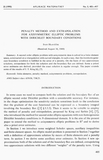Article
Full entry |
 PDF
(2.0 MB)
Feedback
PDF
(2.0 MB)
Feedback
 PDF
(2.0 MB)
Feedback
PDF
(2.0 MB)
Feedback
Keywords:
finite elements; penalty method; axisymmetric problems; extrapolation; a priori error estimates
finite elements; penalty method; axisymmetric problems; extrapolation; a priori error estimates
Summary:
A second order elliptic problem with axisymmetric data is solved in a finite element space, constructed on a triangulation with curved triangles, in such a way, that the (nonhomogeneous) boundary condition is fulfilled in the sense of a penalty. On the basis of two approximate solutions, extrapolates for both the solution and the boundary flux are defined. Some a priori error estimates are derived, provided the exact solution is regular enough. The paper extends some of the results of J.T. King [6], [7].
References:
[1] I. Babuška: The finite element method with penalty. Math. Соmр. 27, (1973), 221 - 228. MR 0351118
[2] J. H. Bramble V. Thomée: Semidiscrete-least squares methods for a parabolic boundary value problem. Math. Соmр. 26 (1972), 633-648. MR 0349038
[3] E.J.Haug K. Choi V. Komkov: Design sensitivity analysis of structural systems. Academic Press, London 1986. MR 0860040
[4] I. Hlaváček M. Křížek: Dual finite element analysis of 3D-axisymmetric elliptic problems. (To appear).
[5] I. Hlaváček: Domain optimization in axisymmetric elliptic boundary value problems by finite elements. Apl. Mat. 33 (1988), 213-244. MR 0944785
[6] J. T. King: New error bounds for the penalty method and extrapolation. Numer. Math. 23, (1974), 153-165. DOI 10.1007/BF01459948 | MR 0400742 | Zbl 0272.65092
[7] J. T. King S. M. Serbin: Boundary flux estimates for elliptic problems by the perturbed variational method. Computing 16 (1976), 339-347. DOI 10.1007/BF02252082 | MR 0418485
[8] J. Nečas: Les methodes directes en théorie des équations elliptiques. Academia, Prague, 1967. MR 0227584
[9] B. Mercier G. Raugel: Resolution d'un problème aux limites dans un ouvert axisymétrique par éléments finis en r, z et séries de Fourier en $\theta$. RAIRO, Anal. numér. 16 (1982), 405-461. DOI 10.1051/m2an/1982160404051 | MR 0684832
[10] M. Zlámal: Curved elements in the finite element method. SfAM Numer. Anal. 10, (1973), 229-240. DOI 10.1137/0710022 | MR 0395263

